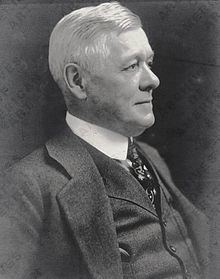John Massey Rhind (9 July 1860 – 1936) was a Scottish-American sculptor. Among Rhind's better known works is the marble statue of Dr. Crawford W. Long located in the National Statuary Hall Collection in Washington D.C. (1926).
Born in Edinburgh, Rhind began his art studies under the tutorage of his father John Rhind, a respected and successful sculptor in the royal burgh. He studied at the Royal Scottish Academy, and continued his education with Jules Dalou, who was at that time living and teaching in Lambeth, England. He then moved to Paris to continue his education for two more years. Upon completing his training he considered moving to the United States but was cautioned by his father not to do so because, “There is no sculptural art in America . . .You’ll starve.”
In 1885 he established a studio with his elder brother William Birnie Rhind, at 217 West George Street, Glasgow, but his brother moved back to Edinburgh 2 years later. At age 29, J. Massey Rhind finally emigrated to the United States in 1889 and settled in New York City. In 1899, Rhind set up a studio and sculpture yard and began residing in Closter, New Jersey.
In February 1890 John Jacob Astor III died and shortly thereafter a competition to create three sets of bronze doors dedicated to him for Trinity Church, New York was announced. Rhind entered the competition, and, along with Charles Niehaus and Karl Bitter, was awarded one of the sets of doors. After this success he never lacked for work and was to generate a large number of public monuments and architectural projects. Nevertheless, Rhind still found time for smaller, private pieces such as a bust of Theodore Roosevelt.
Alexander S. Webb, 1915Abner Doubleday, 1917John Cleveland Robinson, 1917Francis C. Barlow, 1922GIRARD, Stephen: Statue at the Museum of Art in Philadelphia, PennsylvaniaWANAMAKER, John: Statue at the City Hall (east plaza) in Philadelphia, PennsylvaniaLanape Warrior, Wissahickon Creek, Philadelphia, Pennsylvinia 1902Civil War Soldiers & Sailors Monument on Franklin Parkway in Philadelphia, PennsylvaniaJohn C. Calhoun Monument, Charleston, South Carolina, 1896George Clinton Monument, Kingston, New York, 1898 (originally in New York City )Henry Hudson Monument, Kingston, New York, 1898 (originally New York City )James Wolfe Monument, Calgary, Alberta, 1898 (originally New York City )Peter Stuyvesant MonumentRobert Burns Monument, Barre, Vermont, 1899,William T. Sherman Monument, Muskegon, Michigan, 1900Ulysses S. Grant Memorial, Muskegon, Michigan, 1900Statues of Samuel Colt, Colt Park, Hartford, Connecticut. 1902-06Alexander Skene, Grand Army Plaza, Brooklyn, NY 1905Grand Army of the Republic Memorial, Washington, D.C., 1909George Washington, Newark, New Jersey, 1914Bartolomeo Colleoni, reproduction of Andrea del Verrochio’s equestrian sculpture, Newark, New Jersey, 1914National McKinley Birthplace Memorial, Niles, Ohio, 1917Nova Scotia Highland soldier, Cenotaph, Chester, Nova Scotia, 1922Philip Schuyler, Albany, New York, 1925Britannia, Cenotaph, Grand Parade (Halifax), Nova Scotia, 1929Nova Scotia Highland soldier, Cenotaph, New Glasgow, Nova Scotia, 1929Edward Cornwallis, Nova Scotia, 1931"Rufus H. King Memorial Fountain", Washington Park, Albany, New York, 1893: the theme, specified by King's son, J. Howard King: Moses strikes the rock at HorebCorning Fountain, Bushnell Park, Hartford, Connecticut, 1899 bronze and granite, the fountain is 30 feet tall, with a statue of a deer in the middle surrounded by figures of Saukiog Indians, Hartford’s first inhabitants."Fountain of Apollo", Lakewood, New Jersey, 1902The Erskine Memorial Fountain, Atlanta, Georgia, 1896New Haven County Court House, New Haven, Connecticut, 1914 (Architects: William Allen and Richard Williams), facing the New Haven Green.Shelby County Court House, Memphis, Tennessee, 1906–1909 (architects, James Gamble Rogers and H.D.Hale)Alexander Memorial Hall, Princeton University, Princeton, New Jersey, 1892The Cable Building, 611 Broadway at Houston Street, New York City, 1894American Surety Building (now Bank of Tokyo), 100 Broadway, figures at 3rd floor level, New York, 1895 (Architect: Bruce Price)Astor Memorial Doors, Trinity Church, New York, 1896East Pyne, Princeton University, Princeton, New Jersey, 1896"Victory" and "Peace", Grant’s Tomb, New York City, 1897Macy’s caryatids, Macy’s Department Store Building, New York City, 1901"Victory" and "Progress", quadrigas (but with three horses instead of four), Wayne County Building, Detroit, Michigan, 1904United States Courthouse and Post Office, Indianapolis, Indiana, 1904Shelby County Court House, Memphis, Tennessee, 1906–1909Federal Building, Providence, Rhode Island, 1908
